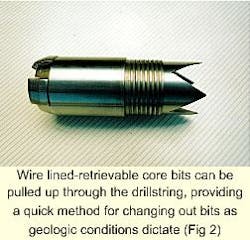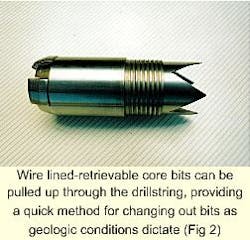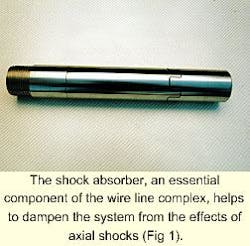The ability to use slim-hole, continuous core-recovery technologies incorporating wire line retrievable core bits, core barrel, and downhole shock absorber offers a new technique for drilling operations.
This is particularly important for drilling operations in remote, difficult, and ecologically vulnerable regions.
Slim-hole drilling saves costs by reducing the hole diameter, resulting in the decreased need for steel, drilling fluid, rig power, and transportation requirements. This technology can be used with less-expensive mining exploration rigs or high-technology, automated slim-hole drilling rigs.
Investigative results by the University of Mining & Geology and Geologoprouchvatelno Predpriatie, both located in Sofia, Bulgaria, show that the application of a small slim-hole drilling rig may provide overall savings of 25-65% comparing to conventional drilling rigs. Additionally, such rigs can minimize environment damage by reducing drilling wastes three fold as compared with conventional drilling rig.
Synergism
The transition to a small-diameter drilling system allows the implementation of the non-stop core drilling approach, widely applied in the mining industry. Thus, the implementation of a simple and reliable wire line-retrievable core-bit system may offer a complete change of attitude towards the use of this technology. Under certain conditions, the usage of the wire line complex has two primary advantages.
First, a reliable wire line-retrievable core bit can complement usage with the wire line-retrievable core barrel. The second advantage can be achieved by diminishing geological risk through the appropriate selection and selective use of drill bits, made according to the specific physical-mechanical properties of the rocks.
In other words, the design of a universal core bit that works equally well in various geological formations and structures is not possible, despite improvements in drill-bit technologies. With a wire line system, however, it becomes feasible to change out drill bits quickly.
A working system, successfully used in Bulgaria by the Sofia Geological Research Enterprise in the eastern regions of Panaguyriste and Bourgas, shows the promise of the wire line complex, having drilled a section of more than 1,000 m using a 76-mm wire line complex.
This complex includes a wire line retrievable core bit, a fixed mechanism for the wire line-retrievable core barrel, and a shock absorber that allows drilling at an equal rate of penetration.
This system had the following attributes:
- The drillstring remains in the hole from the beginning of the coring operation to TD.
- The entire drillstring contains the same ID throughout.
- Transportation means for tripping out worn drill bits and running in new ones is conducted through the drillstring.
- The wire line-retrievable core barrel operates without a hanger ring, requiring very little force to release itself.
- The shock absorber is situated at the bottom of the drill pipe string.
- Tripping operations are entirely eliminated.
Design and action
The wire line complex contains a shock absorber (Fig. 1) that is connected to the outer tube of core barrel, a wire line retrievable core bit (Fig. 2), and a wire line retrievable core barrel that uses an innovative fixing mechanism (Fig. 3). The shock absorber, cap, and segment reamer form the bottom portion of the drillstring.
The shock absorber cushions the assembly from heavy axial loads, thus dampening and eliminating the vibrations and jarring effects that occur during the drilling process. The shock absorber contains steel rings that allow the effects of frictional and elastic forces to be used. The transmission of axial load is realized by the rings while rotational torque is transmitted through a groove junction.
The wire line-retrievable core bit consists of a body, renewable cutting devices, and working parts. The multifunctional body connects with the transport device-the inner core barrel. It also provides orientation abilities.
Latching up
The retrievable core barrel is run down hole under gravitation or by using an overshot. Once it reaches the end of the drillstring, the instrument body automatically orients itself by aligning the reamer with the drillstring. The working elements are fixed in a working position by the inner core barrel that also self actuates in to a working position.
The coring elements, made of a special design, can be quickly replaced. In addition, the cutting mechanism, made of diamonds or PDC disks, can be customized and adapted to specific work conditions.
The wire line-retrievable core barrel consists of a body, an orientating mechanism (fixer), working elements (rollers, socket, and joint), a signal device, and a bearing junction. When running the core barrel down the drillstring, the rollers, under the action of the fixer, automatically set themselves up into a working position once it reaches the outer core barrel.
The lower row of rollers plays the part of a hanger ring while the upper row of rollers adjusts the inner core barrel towards the outer core barrel. Retrieval of a worn core bit is performed either by wire line retrieval of the core barrel or by lowering an overshot. When bit retrieval is not necessary, the core barrel is pulled out by itself.
The overshot allows for multiple connections and the automatic release of the core barrel, preserving itself from deformation through a socket joint that immediately comes into action. The technical characteristic of the complex is determined by the OD of the rock-breaking bit.
The complex is designed for drilling or coring rocks with compressive strengths up to 180-200 MPa, an initial bore-hole inclination of 90-75°, and a maximum rotational speed of 1,000 rpm. Additionally, it can be used with water-based, low-clay, polymeric, and emulsive drilling fluids.
Collar-free drilling
In the horizontal drilling and mining industries, hydraulic thrusters located in the bottom-hole assembly (BHA) generate constant weight on bit without drill collars This reduces dynamic buckling, wear, and hole enlargement while lowering drillstring vibrations.
High-torque connections fitted to 2 7/8-in. drill pipes are recommended for 4 1/8 in. or smaller hole sizes, while 3 1/2-in. drill pipes typically need conventional handling. Slim-hole drilling is more efficient, especially when portable top drive and soft-torque drilling systems are used. The output power needed by polycrystalline diamond compact (PDC) drill bits is 9.6 hp/sq in. (1.5 hp/sq cm), calculating for a working torque of 100 rpm in a 6 3/4-in. hole with 25,000 N-m.
Walker and Milheim treat these and other problems in a detailed article, indicating this system is feasible.2
A successful alternative
The new complex has no analogs in western drilling practice. It has three main advantages. First, the presence of a shock absorber increases penetration rates and footage while decreasing diamond expenditures. Second, because the wire line-retrievable drill bit is a separate device, it provides the following advantages:
- It sets itself up in a working position and is pulled out from the drill-hole with the help of the wire line-retrievable core barrel. It can be run in by gravity, by mud-pump hydraulic activation, or with an overshot.
- Drill bit replacement or evaluation does not depend on the state of the core barrel.
- It entirely eliminates drillstring trips.
- It helps to optimize the drilling process by applying the appropriate tools for each formation and zone of interest.
- It allows the usage of low-quality diamonds, as the retrieval of the bit is quick and easy.
- It decreases energy consumption and preserves the drillstring and the drill tool from wear, resulting in a considerable reduction of failures.
- It contains a simple design with few parts, providing easy maintenance and high reliability.
- Costs per meter are less than with conventional methods.
Third, the fixing device of the wire line-retrievable core barrel is developed on a new principle where the junction between the working details-the rollers and the fixer-work through frictional forces.
This allows:
- A ten-fold reduction in the force required to release the core barrel.
- Drillers to eliminate the use of steel rope, avoiding common problems associates with wear and breakage.
- The ability to work without a hanger ring, normally mounted at the bottom of the drillstring.
The wire line system demands no additional requirements for adaptation with the drillstring and other devices. It is designed to work with conventional drillstrings used in slim-hole drilling and non-stop core recovery. The operating procedure with the wire line system is simple and easy to adopt.
This makes it easy to transfer from one drilling method to another without the difficulties associated with work organization, material-technical provisions, and training issues for rig personnel.
References
- Dupuis, D., "Slim hole system uses special rig, drillstring," IADC Drilling Contractor, July 1993.
- Walker, S.H., and Milcheim, K.K., "An innovative approach to exploration and exploitation drilling: The slim-hole high-speed drilling system," Journal of Petroleum Technology, September 1990, pp. 1184-91.
Bibliography
- Nenkov, N.D., U.S. Patents: No. 4 497 382, No. 4 664 204, No. 5 083 755.
- Nenkov, N.D., Bednarz, S., and Nedyalkov, P., "A face shock absorber for extracting core-collecting pipe-Potentialities and industrial results," Proceedings of The 3rd International Symposium on Planning and Equipment Selection, Istanbul, Oct. 18-20, 1994.
- Sagot, A., and Dupuis, D., "One year experience in slim hole drilling," IADC/SPE Drilling Conference Proceedings, Mar. 12-15, 1996, New Orleans.
The Authors
Nikolai D. Nenkov graduated from the Technical University, Sofia, as a mechanical engineer. He has worked in the Higher Institute of Mining & Geology since 1959, acquiring his PhD in 1974 in the field of drilling techniques.
In addition to more than 20 patents, Nenkov has published over 100 articles and four books. In 1994, he was awarded the "Distinguished Leadership Award" by the American Bibliographical Institute.
Stanislaw G. Bednarz is an assistant professor for drilling at the University of Mining & Metallurgy in Krakow, Poland. He holds an MS (1968) and doctorate (1975) in drilling from the University of Mining & Metallurgy.
Bednarz previously was head of the Department of Drilling and Production Equipment for Land and Offshore Operations. He has authored 70 papers and many reports concerning the design, maintenance, and safety of drilling and production equipment. Bednarz is a technical and marketing consultant for the petroleum industry. He is a Chairman of the Polish Section of SPE.
Peter Vladimirov Nedialkov graduated from the High Mining School in Sofia as a drilling and technology engineer in 1965. From 1965 to 1973, he worked as a drilling engineer for the Geological Enterprise in West Bulgaria. In 1973, Nedialkov became head of the drilling department, senior drilling engineer, and manager for Sofgeoproutchvane Ltd., Sofia.
He has published more than 10 scientific articles and holds five patents in the U.S., Switzerland, Germany, and Russia.





